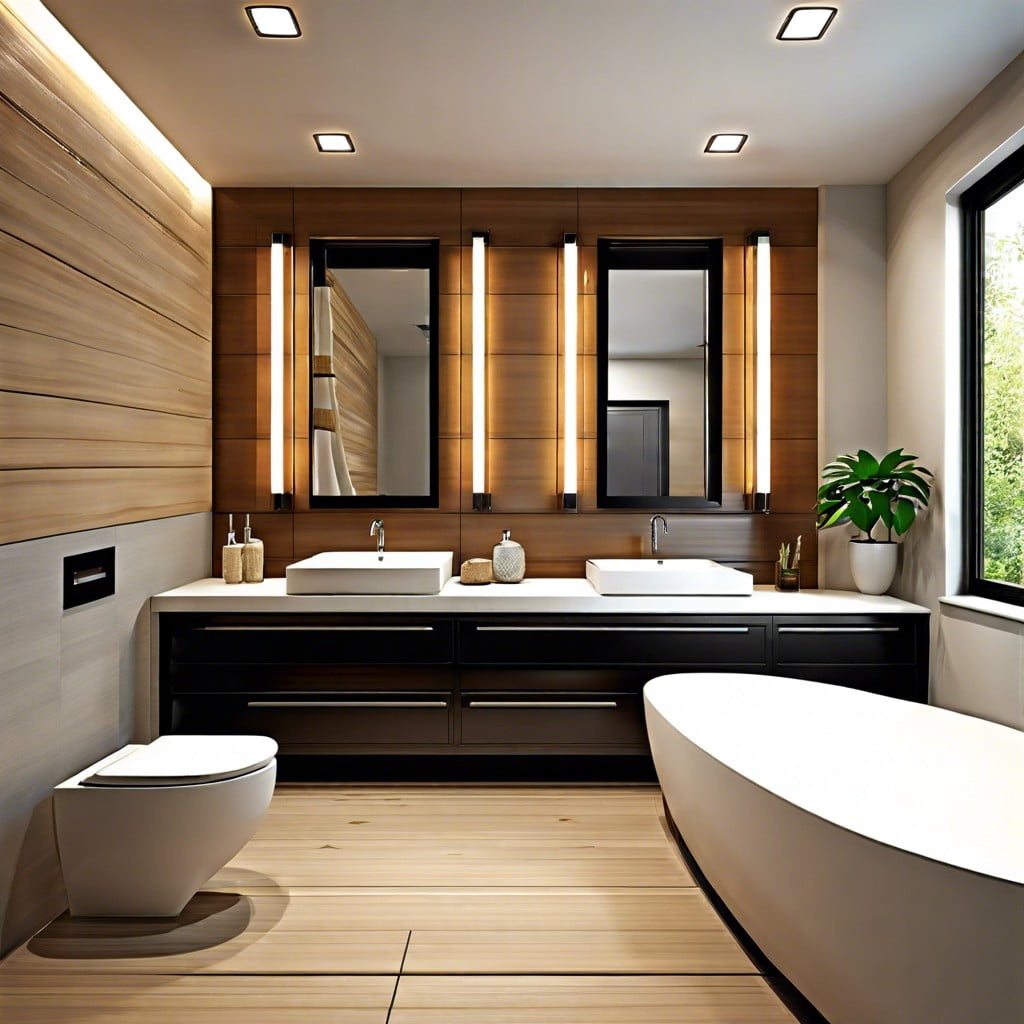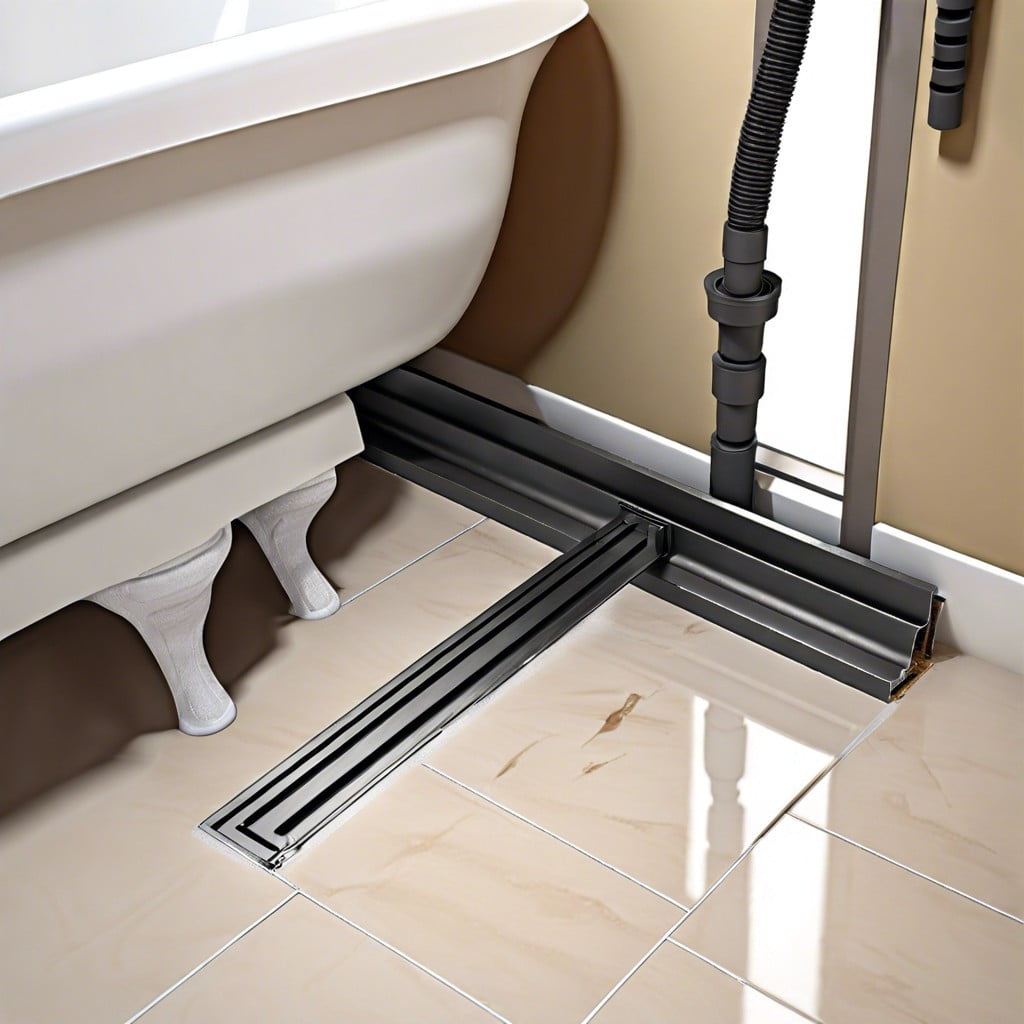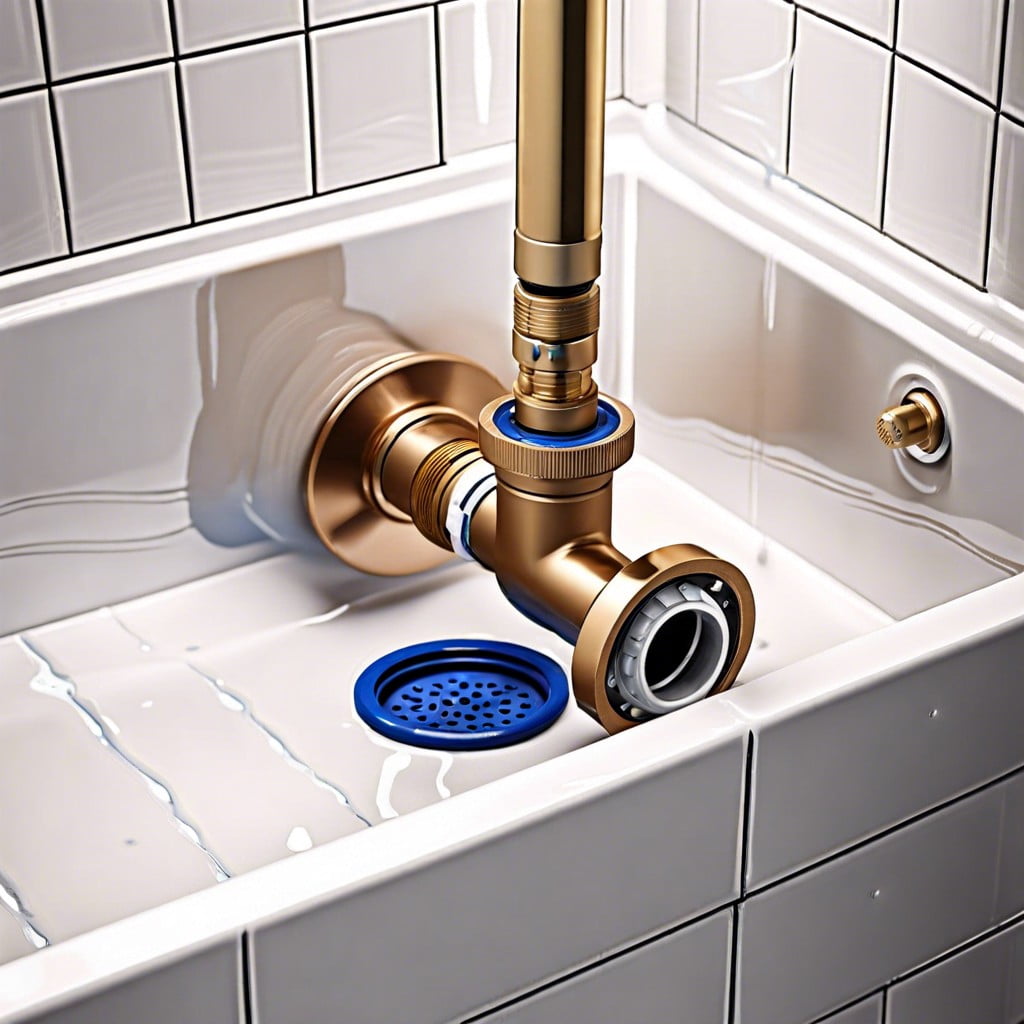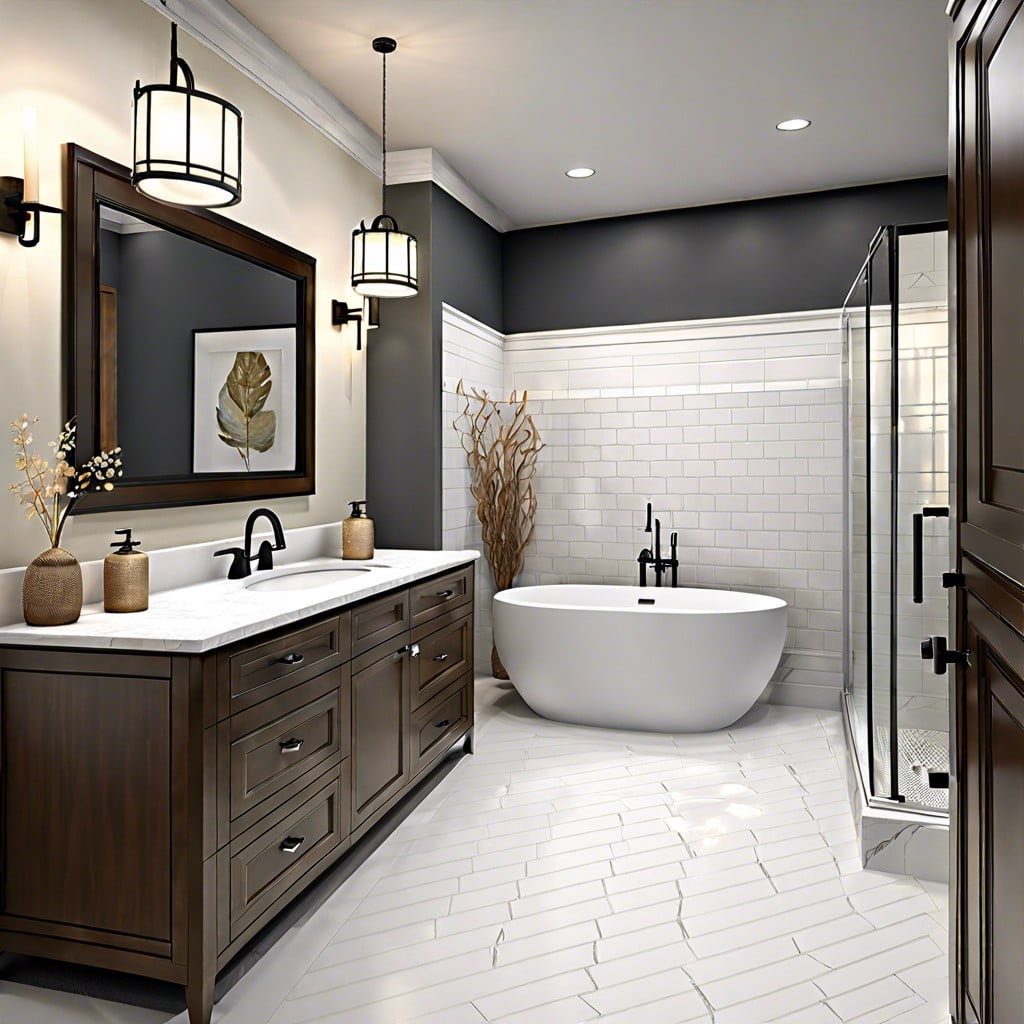Last updated on
Examining the duel between linear and center drains, this article aims to unravel the many reasons why your choice can significantly impact your bathroom’s functionality and aesthetics.
Key takeaways:
- Linear drains offer a sleek, modern look.
- Center drains are a classic choice for standard shower designs.
- Linear drains require specialized installation.
- Center drains require specific floor shaping and structural work.
- Linear drains have better water removal efficiency.
Design Considerations for Linear and Center Drains

When choosing between a linear and center drain, consider how each integrates with your bathroom’s overall design.
Linear drains offer a sleek, modern look and can be placed discreetly along walls or thresholds, seamlessly blending with tile patterns.
On the other hand, center drains typically require a four-way slope and may interrupt the floor’s aesthetic but are a classic choice that works well with standard shower designs.
Evaluate the visual impact of each drain type on your intended style and whether it complements or detracts from your tilework and layout.
Installation Requirements for Linear Drains

Installing a linear drain requires several specific considerations. Firstly, your shower floor needs to be sloped in one direction toward the drain, which often entails custom work and skill.
Linear drains also offer flexibility in placement; they can be installed against a wall or somewhere central on a floor.
It’s important to ensure the waterproofing membrane is correctly applied and intersects seamlessly with the drain.
Additionally, when choosing a linear drain, one must check that it has the appropriate capacity for the expected water flow and that it fits within the intended shower design.
Always consult with a professional to ensure that the installation complies with local building codes and standards.
Installation Requirements for Center Drains

Center drains are typically the traditional choice and have specific installation prerequisites to function effectively. First, the shower floor must slope from all directions towards the drain, requiring a carefully contoured base which often takes the shape of a four-sided pyramid. Installers usually utilize pre-sloped shower pans or mortar to achieve this gradient. It’s essential that the slope is precise — generally a quarter inch per foot — to prevent water pooling and ensure efficient drainage.
For existing bathrooms, retrofitting might necessitate significant alteration to the subfloor, impacting overall project timelines and budgets. The central positioning also means that floor joists may need cutting and reinforcing, necessitating a structural engineer’s input. This is particularly important to maintain the integrity of the shower floor.
Additionally, when selecting tiles, smaller pieces are advisable as they can better conform to the multi-directional slope. Larger tiles may require additional cutting to fit the intricate slopes, complicating the tile installation process.
In summary, installing a center drain requires meticulous floor shaping, may involve substantial structural work, and dictates tile size, all factors that contribute to the installation process.
Space and Layout Suitability

Considering the space and layout of your bathroom is vital when choosing between a linear and center drain. Linear drains are ideal for larger showers and allow for a single slope in the floor, which can be beneficial for both appearance and function. They also open up possibilities for the use of larger tiles and fewer grout lines, leading to a sleek, modern look.
On the other hand, center drains are typically suited for smaller, traditional shower styles and require a four-way slope, which might limit tile size choices due to the need for a gradient. The placement can be more restrictive, usually residing in the middle of the shower, but they can be ideal for compact spaces where design simplicity is favored.
It’s important to consider not only the present layout but also any future renovations that may be desired. Make sure the choice aligns with both the present aesthetics and functional needs, as well as those projected for the future.
Water Removal Efficiency Comparison
When weighing efficiency in water removal, linear drains often take the lead. Their elongated design allows for smooth water flow towards one exit point, which is particularly advantageous in barrier-free showers where water needs directional guidance.
By contrast, center drains require strategic sloping from all directions to collect water in a single spot, which may sometimes result in puddling if not perfectly leveled. With linear drains, you also get the added benefit of placing them against the wall, thereby minimizing the slope length from the shower space and enhancing the drainage speed.
It’s essential to consider the layout of your space and the capacity of the drainage system to ensure excess water is effectively managed.
Cleaning and Maintenance: Linear Vs Center Drains
Maintaining a clean and functional shower environment is paramount, no matter the drain type chosen. When considering a linear drain, it simplifies cleaning due to its single-direction slope which directs debris and water towards the drain channel. The grate can be easily lifted for routine cleanup, allowing access to the channel for removing hair and soap residue. Furthermore, fewer crevices exist, reducing the potential for mold and mildew buildup.
On the flip side, center drains require more strategic angling of the shower floor to ensure proper drainage from all sides, potentially creating more corners that need attention during cleaning. However, with a single point of collection, hair and residue can be quickly removed from the central screen. Regular checks for clogs are necessary to prevent water from pooling and compromising the shower’s integrity.
Both styles mandate consistent cleaning schedules to uphold optimal function and hygiene. It’s also important to use appropriate cleaning agents according to the material of the drain to prevent damage and to maintain a spotless appearance.
Aesthetic Appeal of Linear and Center Drains
Linear drains offer a sleek, modern look with their straight lines and often come in a variety of finishes to match any bathroom decor. They can be installed discreetly against the wall, providing an uninterrupted floor design that enhances the sense of space. The uninterrupted tile pattern contributes to a sophisticated and minimalist feel.
On the other hand, center drains require a point-focused floor slope, which can interrupt the tile pattern but allows for a classic look that fits well in various bathroom styles. With a range of decorative covers, center drains can be easily adapted to match the bathroom’s aesthetic, though they remain more conspicuous than linear options.
Both drain types can serve as a statement piece or a subtle design element depending on the chosen finish and cover style. The key is to select a drain that complements the bathroom’s overall theme and meets your personal taste.
Options for Customization
Exploring the customization options for both linear and center drains opens up a realm of design flexibility. Linear drains cater to a minimalist and modern aesthetic, often available in various finishes, such as polished chrome, matte black, or brushed nickel. They can also be camouflaged within the shower floor with tile-in options.
Center drains, traditionally, offer different shapes like round or square and come with assorted grate patterns to match bathroom fixtures. Both types can accommodate custom-designed grates for a unique touch, echoing the broader style of the bathroom. Notably, linear drains can span the shower’s entire width, creating a seamless look, while center drains provide a classic appearance that can be personalized with decorative covers.
Accessibility and Safety Features
Selecting the right drain for your shower isn’t just about aesthetics; it also has significant implications for accessibility and safety. For those requiring barrier-free access, such as wheelchair users or individuals with limited mobility, linear drains are often the superior choice. They allow for the construction of showers without curbs and can be placed directly against the wall, creating a smooth transition from bathroom floor to shower floor.
On the other hand, center drains require the shower floor to slope in four directions, often resulting in the need for a shower curb to contain water. This can be an obstacle for those with mobility challenges. In terms of safety, linear drains also offer a more consistent floor pitch, reducing the potential for slips and falls, a crucial consideration for vulnerable users.
Both drain types should have non-slip surfaces and be made of materials that resist the growth of mold and mildew to ensure a safe and clean shower environment. Remember, thoughtful drain placement, along with the selection of an appropriate design, can greatly enhance the safety and accessibility of your bathroom for all users.
Cost Comparison
When comparing the costs between linear and center drains, several factors come into play:
- Initial Purchase Price: Linear drains tend to be more expensive upfront due to their more complex design and construction. In contrast, center drains are usually more budget-friendly.
- Installation Costs: The installation process for linear drains can be more intricate and labor-intensive, potentially increasing the cost of labor. Center drains, often being simpler to install, may result in lower labor costs.
- Tiling Expenses: Linear drains often require the bathroom floor to slope in one direction, which can simplify tile cutting and reduce waste. However, the tiles themselves may be more costly if a specific style is needed to match the drain. Center drains require a multi-directional slope, which could increase the complexity and cost of tiling.
- Long-Term Value: Investing in a linear drain may add to the property’s value due to its modern appeal and efficient drainage, potentially offsetting the initial higher cost.
Remember, while the initial price is an important consideration, factoring in the longevity and added value to your home is equally valuable when making your decision.
Compatibility With Various Flooring Materials
When choosing between linear and center drains, flooring materials play a significant role. Tiles are versatile and work well with both types, allowing for a tailored cut around linear drains or a centered design for traditional drains.
With large-format tiles, linear drains are particularly advantageous as they require fewer cuts for a seamless look. Mosaic tiles, on the other hand, offer more flexibility for contouring around center drains.
For stone slabs, a linear drain is optimal, providing a sleek, continuous surface without interruptions. Moreover, various new waterproofing and underlayment techniques align specifically with either drain style, ensuring compatibility and long-term performance of your chosen flooring.
Drainage Performance in Large Showers
In expansive shower spaces, drainage performance is critical to prevent water pooling and ensure a dry, safe surface. Linear drains, spanning the shower’s length, catch water across a broader area, making them highly effective for large showers. Their design allows for a single slope in the shower floor, which enhances water flow towards the drain, reducing the chance of standing water.
Contrastingly, center drains require a four-way pitch in the tile work to direct water from all corners. This could be less efficient in larger showers, as water has to travel further to reach the central point, potentially leading to slower drainage. When planning your shower, consider the shower’s dimensions and ensure the chosen drainage system can handle the volume of water efficiently.
High-Flow Showers: Drainage Capacity
For high-flow showers, robust drainage is crucial to prevent water buildup. Linear drains tend to accommodate higher flow rates due to their elongated design, which collects water along a larger surface area and funnels it away more efficiently.
Conversely, center drains handle less volume due to their smaller size and singular point of collection. When opting for a center drain in a high-flow shower, ensure it’s sufficiently rated for your shower head’s output. Upgrading to a model with a wider diameter can improve capacity.
Importantly, local building codes may dictate minimum requirements for drain sizes, which should be consulted during the planning stage to guarantee compliance and optimal functionality.
The Impact of Drain Placement On Shower Waterproofing Systems
Drain placement plays a pivotal role in the effectiveness of shower waterproofing systems. With a linear drain, waterproofing is streamlined as the gradient of the shower floor only slopes in one direction, directing water toward the elongated drain. This singular slope simplifies the waterproofing process, often resulting in a more reliable seal as there are fewer angles and corners to contend with.
In contrast, a center drain requires a four-way slope, converging at the drain point. This can be more complex to construct and waterproof properly. Each additional seam or angle increases the risk of a breach in the membrane, potentially leading to leaks. Consequently, precision is crucial in the layout and installation of the membrane to ensure all paths lead directly to the drain without any gaps for water to escape.
It’s important to note that the type of waterproofing system used may also vary depending on the drain selection, with some systems better suited to linear setups and others more compatible with traditional center drains.
While both drain types can be successfully integrated into effective waterproofing systems, the chosen drain placement should be informed by a careful evaluation of the specific needs and structure of the shower area to ensure the longevity and efficacy of the waterproofing solution.
How Can I Receive More Information On Remodeling My Shower?
For comprehensive resources on shower remodeling, start with home improvement stores and their websites; they often provide free guides and project calculators. Consulting with a licensed plumber or contractor can offer tailored advice and help you understand code requirements. Websites of companies specializing in bathroom products frequently have inspiration galleries and technical downloads. Home design magazines and online platforms like Houzz or Pinterest can ignite creativity and showcase the latest trends.
For interactive assistance, consider attending local home expos or workshops. For virtual help, numerous webinars and YouTube tutorials are available from both professionals and experienced DIYers. Remember, proper research and planning are crucial to ensuring a successful remodel tailored to your specific needs and preferences.
FAQ
Should I get a center or linear shower drain?
A linear drain is optimal if you have family members with mobility issues or recovering from surgery, but for a conventional, cost-effective solution, a center square drain is recommended.
What are the cons of linear drains?
The main disadvantage of linear drains is the frequent cleaning required due to their design, which slows down water flow, leading to an accumulation of hair, dirt, and grime.
Why are linear drains more expensive?
Linear drains often carry a higher price tag due to their custom design and the added labor costs associated with their installation.
Do linear drains clog easier?
The design and length of linear drains make them more prone to clogging by hair and debris due to their smaller gutter pitch.
How does the installation process compare for a linear versus a center shower drain?
The installation process for a linear shower drain often requires more advanced planning and precision due to its long, slim design compared to the simpler center shower drain that is typically easier and quicker to install.
Can linear drains be customized to match bathroom decor?
Yes, linear drains can be customized to match bathroom decor.
What maintenance is required for a center versus a linear shower drain?
Center shower drains require regular cleaning to remove hair and soap scum, whereas linear drains, having greater grating surface area and designed for larger volume of water, tend to necessitate less frequent, but similar maintenance.
Recap




